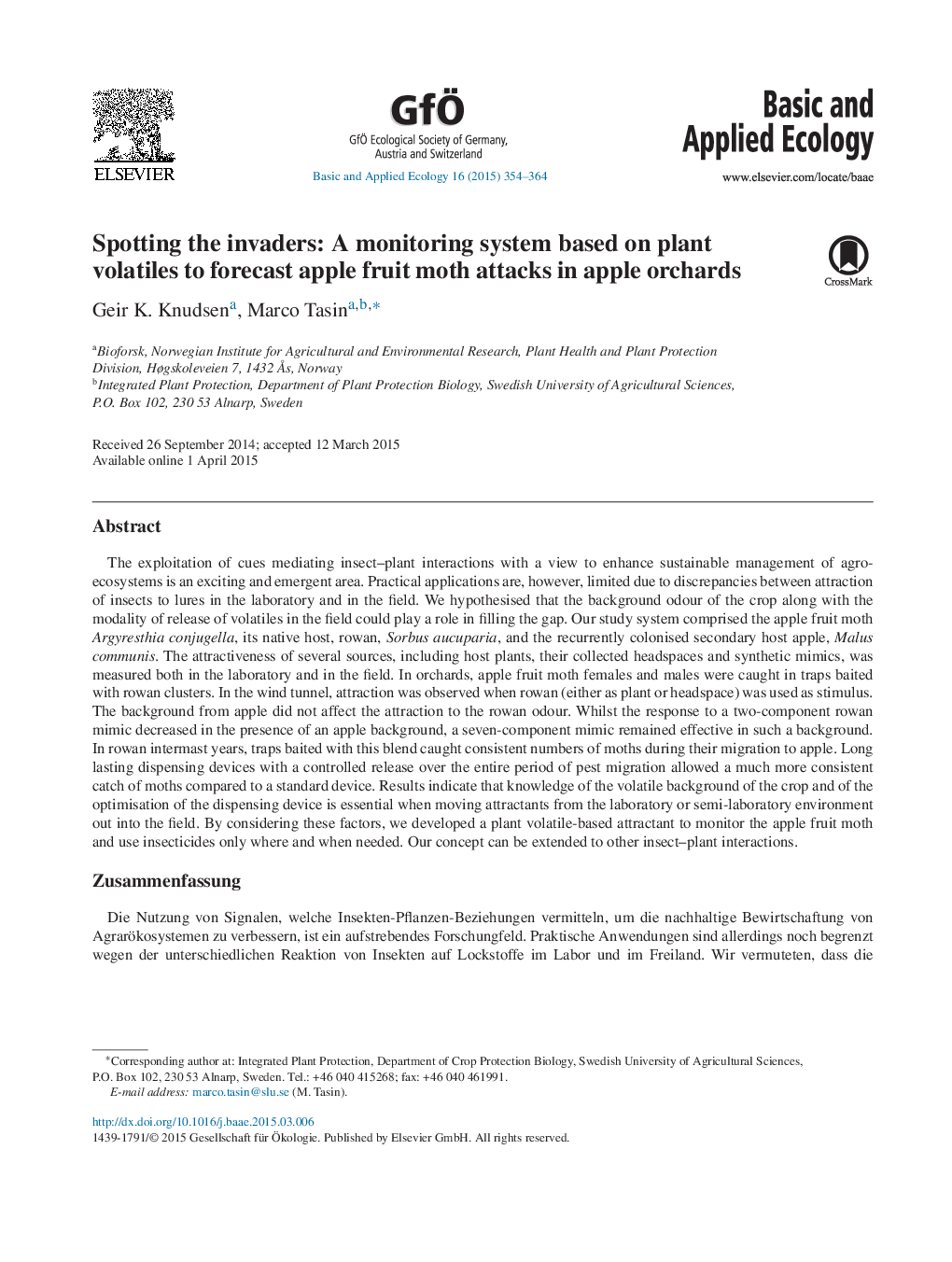| کد مقاله | کد نشریه | سال انتشار | مقاله انگلیسی | نسخه تمام متن |
|---|---|---|---|---|
| 4384103 | 1304389 | 2015 | 11 صفحه PDF | دانلود رایگان |
The exploitation of cues mediating insect–plant interactions with a view to enhance sustainable management of agro-ecosystems is an exciting and emergent area. Practical applications are, however, limited due to discrepancies between attraction of insects to lures in the laboratory and in the field. We hypothesised that the background odour of the crop along with the modality of release of volatiles in the field could play a role in filling the gap. Our study system comprised the apple fruit moth Argyresthia conjugella, its native host, rowan, Sorbus aucuparia, and the recurrently colonised secondary host apple, Malus communis. The attractiveness of several sources, including host plants, their collected headspaces and synthetic mimics, was measured both in the laboratory and in the field. In orchards, apple fruit moth females and males were caught in traps baited with rowan clusters. In the wind tunnel, attraction was observed when rowan (either as plant or headspace) was used as stimulus. The background from apple did not affect the attraction to the rowan odour. Whilst the response to a two-component rowan mimic decreased in the presence of an apple background, a seven-component mimic remained effective in such a background. In rowan intermast years, traps baited with this blend caught consistent numbers of moths during their migration to apple. Long lasting dispensing devices with a controlled release over the entire period of pest migration allowed a much more consistent catch of moths compared to a standard device. Results indicate that knowledge of the volatile background of the crop and of the optimisation of the dispensing device is essential when moving attractants from the laboratory or semi-laboratory environment out into the field. By considering these factors, we developed a plant volatile-based attractant to monitor the apple fruit moth and use insecticides only where and when needed. Our concept can be extended to other insect–plant interactions.
ZusammenfassungDie Nutzung von Signalen, welche Insekten-Pflanzen-Beziehungen vermitteln, um die nachhaltige Bewirtschaftung von Agrarökosystemen zu verbessern, ist ein aufstrebendes Forschungfeld. Praktische Anwendungen sind allerdings noch begrenzt wegen der unterschiedlichen Reaktion von Insekten auf Lockstoffe im Labor und im Freiland. Wir vermuteten, dass die Hintergrunddüfte der Feldfrucht zusammen mit der Art und Weise der Duftstofffreisetzung im Freiland eine Rolle spielen könnten. Unser Untersuchungssystem bestand aus der Ebereschenmotte (AFM), Argyresthia conjugella, mit ihrer natürlichen Wirtspflanze Sorbus aucuparia (Eberesche) und der sekundären Wirtspflanze Malus communis. Die Attraktivität von Wirtspflanzen und anderen Duftquellen wurde im Labor und Freiland anhand gesammelter Duftproben untersucht, sowohl mit Extrakten aus Dampfraumanalysen als auch mit synthetischen Nachahmungen. AFM-Weibchen wurden in Apfelplantagen gefangen. In Windtunnelexperimenten waren sowohl Eberesche als auch deren Duftraumextrakte attraktiv. Die „Duftkulisse” der Äpfelbäume (Volatile die nicht von der Eberesche stammen) beeinträchtigte die Attraktivität der Eberesche nicht. Wenn zusätzlich zur Apfelduftkulisse nur zwei Komponenten des Ebereschenbouquets verwendet wurden, ergab sich eine Verminderung der Attraktivität. Bei gleichzeitiger Verwendung von sieben Komponenten des Ebereschenbouquets verschwand jedoch der attraktivitätsmindernde Effekt durch die Apfelduftkulisse. In Zwischenmastjahren der Eberesche konnten Duftfallen gleichmäßige Zahlen von Ebereschenmotten abfangen, die zu den Apfelbäumen migrierten. Lang anhaltende Duftspender mit kontrollierten Emissionsraten erlaubten wesentlich beständigere Fangzahlen im Vergleich zu Standardduftspendern. Unsere Ergebnisse weisen darauf hin, dass Kenntnisse zur Duftstoffkulisse und die Optimierung der Duftspender essentiell für eine erfolgreiche Übertragung vom Labor ins Freiland sind. All diese Faktoren berücksichtigend, entwickelten wir ein Pflanzenemission-basiertes Attraktans, um AFM optimal überwachen zu können, sodass Insektizide nur dann eingesetzt werden müssen, wo und wann sie wirklich gebraucht werden. Unser Konzept kann auf andere Insekten-Pflanzen-Beziehungen übertragen werden.
Journal: Basic and Applied Ecology - Volume 16, Issue 4, June 2015, Pages 354–364
